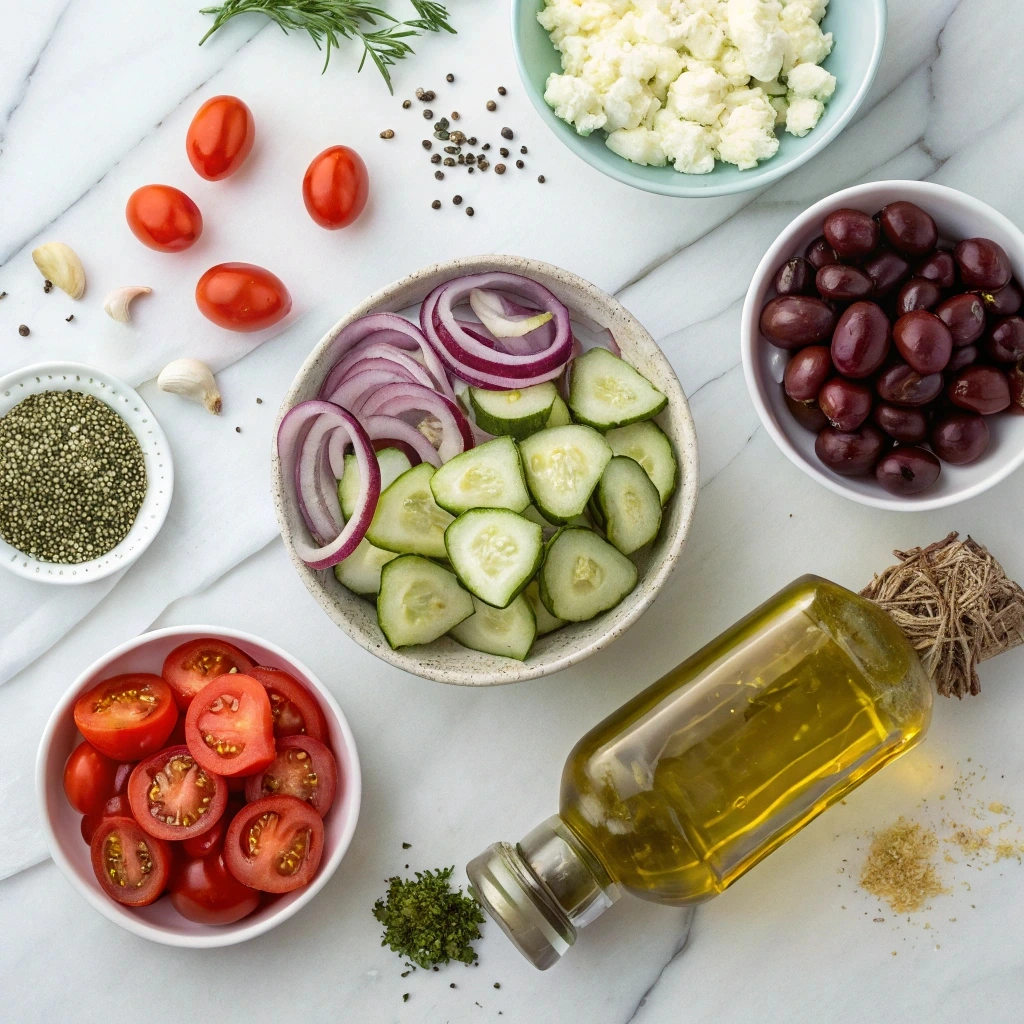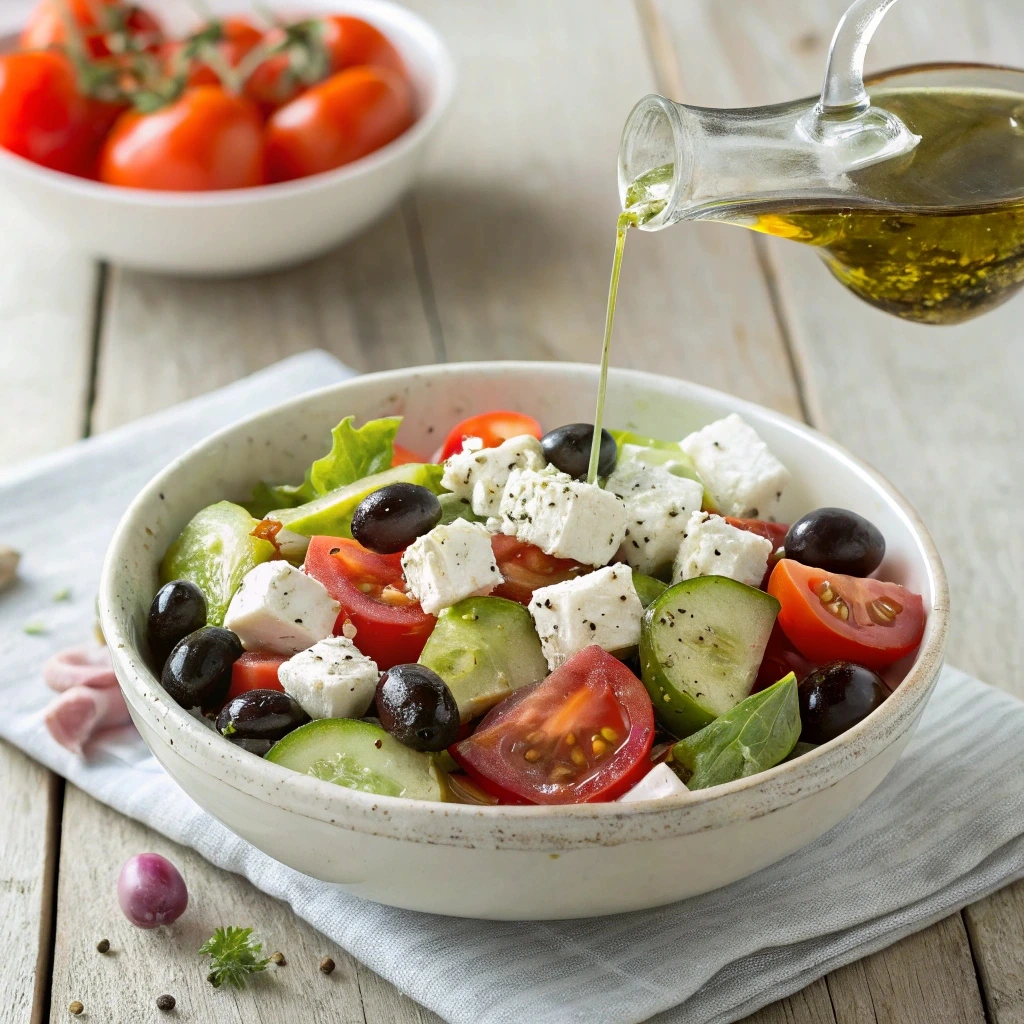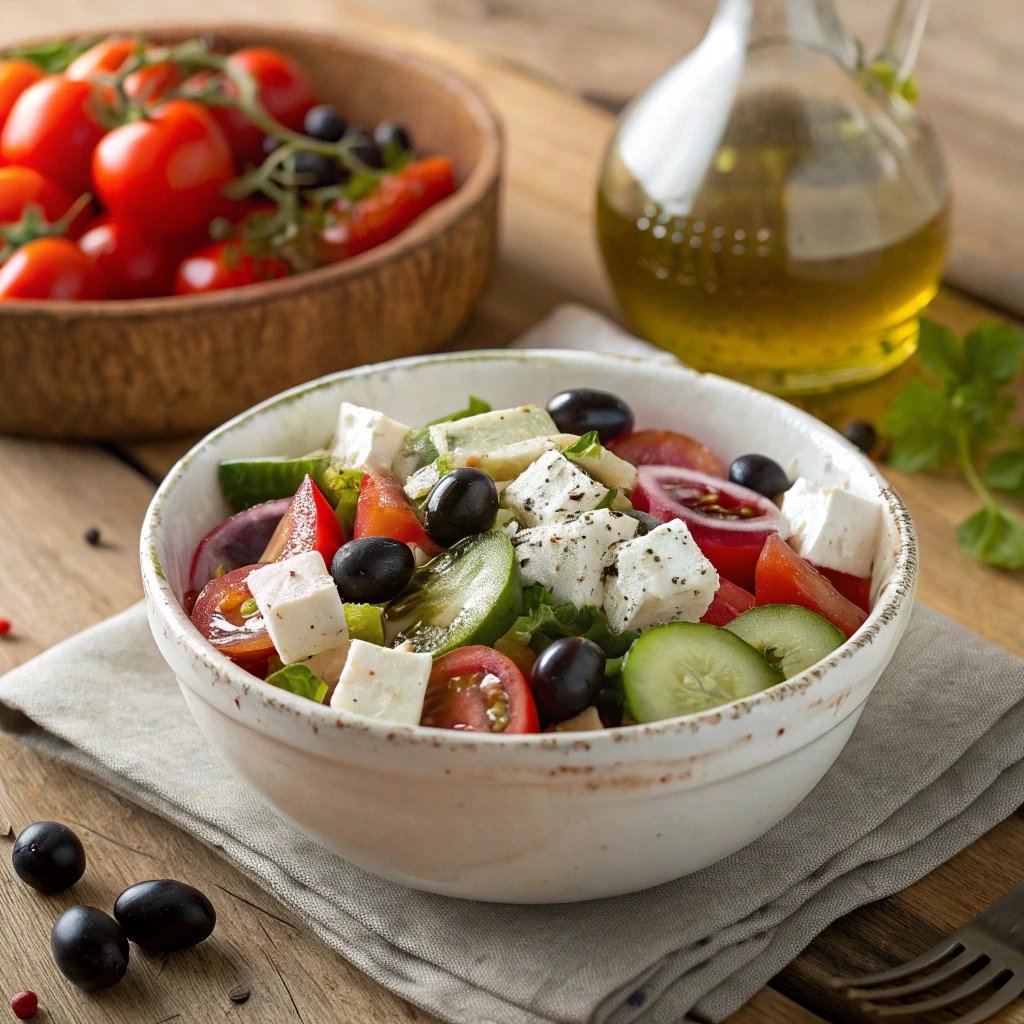If you’re craving something light, fresh, and bursting with Mediterranean goodness, you’re in the right place. This guide is all about the classic Greek salad recipe—a dish that’s as simple as it is sensational. Whether you’re prepping a quick lunch, throwing together a colorful side for dinner, or planning a healthy potluck dish, this salad delivers.
We’ll walk you through the authentic ingredients, step-by-step instructions, fun variations, pairing tips, nutrition breakdown, and even smart prep ideas. Oh—and we’ll answer the most Googled questions like “Does Greek salad recipe have lettuce?” and “Can I swap out the feta?”
So grab your tomatoes and olive oil, because we’re heading to flavor town—Greek style.
Table of Contents
What is a Greek salad recipe?
Origins of the Traditional Greek salad recipe
Let’s rewind for a sec. The Greek salad, known locally as Horiatiki, isn’t just a random mix of veggies—it’s a cultural icon. Born in the heart of rural Greece, this rustic dish was the go-to meal for farmers and villagers using what was fresh, local, and seasonal. No fancy frills. Just ripe tomatoes, crisp cucumbers, briny olives, red onions, and a slab of creamy feta—all tied together with a drizzle of bold Greek olive oil.
Unlike many Western-style salads, this one doesn’t rely on lettuce. In fact, authentic Greek salad typically skips it altogether. The focus stays on the big, bold Mediterranean flavors, making each bite feel like sunshine in your mouth.
What Makes a Salad “Greek”? Key Characteristics
Okay, so what sets a Greek salad recipe apart from the pack? First off, it’s all about quality over quantity. Think fewer ingredients, but each one bringing its A-game.
- Tomatoes should be juicy and sweet—preferably vine-ripened.
- Cucumbers? Firm, cool, and crisp.
- Feta? Always in blocks, never crumbled in advance.
- And the dressing? No creamy concoctions here—just extra virgin olive oil, dried oregano, and maybe a splash of red wine vinegar.
Moreover, this salad celebrates texture. From the crunch of cucumber to the creamy bite of feta and the pop of olives—it’s got balance. Therefore, it’s no wonder this humble dish has earned a spot on tables around the globe.
In the end, the Greek salad recipe is more than just food—it’s tradition, simplicity, and bold taste wrapped into one irresistible bowl.
Essential Ingredients in a Greek Salad Recipe

Fresh Vegetables: Tomatoes, Cucumbers, and Red Onions
The heart and soul of any great Greek salad recipe lies in its fresh produce. Without these veggies, it’s just not the real deal. So let’s break it down.
First up, tomatoes. You’ll want them ripe, juicy, and full of flavor. Cherry or vine-ripened varieties are ideal. However, if you’re in a pinch, any sweet, firm tomato will work.
Next, cucumbers bring that refreshing crunch. Traditional recipes use English cucumbers, but you can also go with Persian or regular garden ones—just peel and seed them if the skin is thick.
Then there’s the red onion, which adds sharpness and bite. For a milder flavor, soak the sliced onion in cold water for about 10 minutes before adding it to your bowl. This little trick tones down the intensity, while keeping the flavor alive.
The Role of Feta Cheese and Kalamata Olives
Now let’s talk about the good stuff—feta and olives. These two are the umami bomb that takes this dish from basic to bold.
Always go for Greek feta in blocks, stored in brine. Crumbled feta just doesn’t have the same creamy texture or salty tang. And for olives, Kalamata is the king. Their dark purple hue and rich, fruity taste are just unbeatable.
Moreover, these ingredients aren’t just tasty—they bring a salty contrast to the fresh veggies, which makes the whole thing pop.
Choosing the Right Olive Oil and Herbs
You’ve got your veggies and toppings, now it’s time to bring it all together. Extra virgin olive oil is non-negotiable. It’s the dressing, the flavor booster, and the final touch that makes everything sing. Look for a bold, peppery Greek EVOO for best results.
For herbs, dried oregano is traditional—don’t skip it! It adds an earthy aroma that balances the salad beautifully. You might also add a dash of red wine vinegar for acidity, though purists often leave it out.
🥗 Ingredient Table for Classic Greek Salad
| Ingredient | Quantity |
|---|---|
| Vine-ripened tomatoes | 4 large, cut into wedges |
| Cucumber | 1 medium, peeled & sliced |
| Red onion | ½, thinly sliced |
| Kalamata olives | 16 whole, pitted |
| Greek feta cheese (block) | 85g (about 3 oz), cubed |
| Extra virgin olive oil | 4 tbsp |
| Dried oregano | 1 tsp |
| Red wine vinegar (optional) | 1 tbsp |
| Salt & black pepper | To taste |
Step-by-Step Instructions: How to Make Greek Salad

Prepping and Cutting the Vegetables
Making a Greek salad recipe might be easy, but the details matter. First, wash and dry all your veggies. Then, cut the tomatoes into wedges—not slices. This helps release their juices and adds body to the salad.
Cucumbers should be sliced into half-moons or chunks, depending on your preference. Meanwhile, red onions should be sliced paper-thin to avoid overpowering other flavors. If you’ve got time, soak them in cold water with a splash of vinegar—it works wonders.
Therefore, prepping thoughtfully makes a huge difference in texture and taste.
Assembling the Salad with Proper Layering
Now comes the fun part: assembling your masterpiece. In a large bowl or shallow serving dish, start layering the ingredients.
Begin with cucumbers and tomatoes, followed by red onions and olives. Then, place big cubes—or even a slab—of feta cheese on top. Sprinkle dried oregano generously over the whole thing.
You could toss the salad gently at this stage, but traditionally, Greek salads are mixed gently at the table. This way, the feta and juices from the veggies mix just right when served.
Mixing the Dressing and Final Toss
Here’s the secret sauce—literally. Mix 4 tablespoons of extra virgin olive oil with a tablespoon of red wine vinegar (if using), a pinch of salt, and a few grinds of pepper.
Drizzle it evenly over the salad. Don’t drown it, though—this isn’t your typical dressing-heavy dish. Instead, the oil acts as a flavor enhancer and ties everything together.
As a result, every bite feels light, balanced, and satisfying.
Presentation Tips: How to Serve Like a Pro
Want to wow your guests? Serve your Greek salad recipe in a wide, shallow bowl with a big spoon and fork for sharing. Garnish with a sprinkle of oregano and an extra drizzle of oil.
In addition, you can serve it with crusty bread on the side to soak up all the flavorful juices pooling at the bottom.
Finally, serve it chilled or at room temp—never straight from the fridge. That little tip alone will level up your salad game.
Customizing Your Greek Salad
How to Make It Your Own
While the classic Greek salad recipe is undeniably delicious, adding your personal twist can make it even more special. To begin with, consider swapping traditional feta cheese for a creamy goat cheese or a vegan alternative if you’re dairy-free. Additionally, incorporating grilled chicken or shrimp can turn this salad into a hearty main dish.
Moreover, for those who love a little crunch, toasted pine nuts or crushed pita chips make great toppings. Some home cooks also enjoy mixing in seasonal vegetables such as avocados or roasted bell peppers. These additions not only enhance the flavor but also add texture and nutrition.
For more flavorful variations, don’t hesitate to play around with fresh herbs. While oregano is a staple, mint and dill offer refreshing alternatives that bring a new layer of taste to your bowl.
💡 Tip: If you’re into healthy salad recipes, you might also enjoy the Roasted Beet Salad with Goat Cheese, another bright and customizable dish that pairs beautifully with Mediterranean flavors.
Dietary Adjustments and Substitutes
Even though Greek salad is already gluten-free and vegetarian, it can be modified to suit other dietary preferences. If you’re watching your sodium intake, go for low-sodium olives and rinse the feta cheese to reduce saltiness. On the other hand, vegans can swap out feta for almond-based cheese or marinated tofu cubes.
Additionally, those avoiding oil can make a lighter dressing using lemon juice, red wine vinegar, and a touch of mustard for an emulsion without added fats. These substitutions not only retain the core flavors of the salad but also cater to a wider range of dietary needs.
Serving Suggestions and Pairings
What to Serve with Greek Salad
Greek salad is a versatile dish that complements a variety of meals. For a light lunch, serve it with a slice of crusty whole grain bread or warm pita. When preparing dinner, it pairs exceptionally well with grilled fish like salmon or sea bass. The bright, citrusy elements of the salad balance beautifully with smoky, charred meats.
Furthermore, this salad makes an excellent side for a mezze spread. Pair it with hummus, baba ganoush, or dolmas for an authentic Mediterranean experience.
🍽️ Pairing Idea: Try it alongside the Baked Feta Pasta with Cherry Tomatoes for a complete Greek-inspired meal that’s both rich and refreshing.
Ideas for Leftovers and Meal Prep
Greek salad holds up surprisingly well as leftovers, especially when stored without the dressing. In fact, letting the veggies marinate for a few hours can deepen the flavors. To meal prep, keep the chopped ingredients in separate containers and mix only before serving.
If you have leftovers, toss them into a wrap with some grilled chicken or falafel for a quick lunch. Alternatively, blend them into a cold pasta salad for a next-day refresh.
👉 Need more lunch ideas? Check out Easy Mediterranean Chickpea Salad — it’s another nutrient-packed option perfect for busy weekdays.
Storing and Making Ahead
Best Practices for Storing Greek Salad
If you’ve got leftovers or you’re prepping ahead, storing your Greek salad recipe the right way keeps it tasting fresh and crisp. First things first—avoid dressing the entire batch if you don’t plan to eat it all at once. Instead, store the chopped veggies in an airtight container and keep the dressing separate in a small jar.
Moreover, it’s best to keep delicate ingredients like feta and olives stored on top of the salad or even in their own containers. This way, they won’t overpower the other flavors during storage. For best results, consume the salad within 2 to 3 days, although the dressing can last up to a week in the fridge.
Tips for Meal Prep and Planning
Planning ahead? This Greek salad recipe is a dream for meal preppers. Chop all the vegetables—cucumbers, tomatoes, and onions—ahead of time and keep them dry to avoid sogginess. For busy weekdays, pre-pack single servings in meal containers with a small cup of dressing on the side.
Additionally, you can batch-cook add-ins like grilled chicken or roasted chickpeas and keep them refrigerated to mix into the salad at the last minute. As a result, your lunch or dinner will be ready in just minutes, making healthy eating feel effortless.
💡 Pro tip: If you’re prepping for a party, prepare all the elements separately and toss everything together right before serving. This keeps it vibrant and fresh for your guests.
Common Mistakes to Avoid
Overdressing the Salad
One of the most common pitfalls when making a Greek salad recipe is using too much dressing. While it’s tempting to pour it all in, this can make the salad soggy and mask the fresh flavors of the vegetables. Instead, start with a small amount and gradually add more as needed. You want the dressing to coat the ingredients, not drown them.
Moreover, letting the salad sit too long in the dressing causes the cucumbers and tomatoes to release excess moisture. This dilutes the taste and affects the texture. Therefore, always dress it just before serving if possible.
Choosing Low-Quality Ingredients
Because this dish is so simple, every ingredient matters. Using out-of-season tomatoes or pre-packaged crumbled feta can result in a salad that tastes flat. So, opt for fresh, ripe produce and good-quality cheese. Extra virgin olive oil and authentic Kalamata olives can also make a big difference.
In addition, don’t skip the herbs! Even a sprinkle of dried oregano or fresh parsley boosts the flavor profile significantly. Small choices like these elevate your Greek salad recipe from basic to brilliant.
🍅 Want to explore more Mediterranean salad tips? Don’t miss the Fresh Tomato Basil Mozzarella Salad for another simple yet bold dish.

Frequently Asked Questions (FAQs)
Can I make a Greek salad recipe ahead of time?
Yes, you can—but with a few smart tips. To keep your Greek salad recipe crisp and flavorful, chop all the vegetables in advance and store them in airtight containers. However, don’t add the dressing or feta cheese until just before serving. This prevents sogginess and helps the ingredients stay fresh.
In fact, prepping the dressing separately and keeping it in a sealed jar in the fridge means you can toss everything together in seconds when you’re ready to eat.
Is it okay to use bottled dressing?
Technically, yes—but it’s not ideal. Bottled dressings often contain added sugars, preservatives, and flavorings that can overpower the simple beauty of a traditional Greek salad recipe. Instead, making your own dressing with olive oil, red wine vinegar, oregano, salt, and pepper takes just a minute and tastes way better.
Moreover, homemade dressing lets you control the ingredients, which is great for people with dietary needs.
What protein goes best with Greek salad?
This refreshing salad pairs wonderfully with a variety of proteins. Grilled chicken, lamb, or shrimp are all fantastic choices. In addition, chickpeas or white beans work great for a vegetarian-friendly version.
For more inspiration, check out the Greek-Style Chicken Skewers recipe. It’s an excellent main dish to serve with your salad for a full Mediterranean meal.
Can I add lettuce to Greek salad?
Traditionally, no. An authentic Greek salad doesn’t include lettuce. However, if you enjoy the crunch or want to stretch the salad to feed more people, feel free to mix in some romaine or iceberg lettuce. Just keep in mind, doing so moves it away from the classic version.
How long does Greek salad last in the fridge?
When stored properly without dressing, your Greek salad recipe can last up to 2–3 days in the fridge. However, once it’s dressed, it’s best eaten within 24 hours for the freshest taste and texture.
Conclusion: Mastering the Greek Salad Recipe
Why This Recipe Should Be a Go-To
The Greek salad recipe is more than just a quick and healthy dish—it’s a celebration of fresh ingredients, bold flavors, and Mediterranean simplicity. Whether you’re whipping it up as a side, a lunch, or the star of your dinner table, it delivers every time.
Moreover, it’s incredibly versatile. You can tweak it to match your taste, dietary needs, or what you’ve got on hand. It’s also a beautiful meal to share, easy to prep, and always a crowd-pleaser.
Final Thoughts and Encouragement to Try
If you haven’t tried making this at home yet, now’s the time. With just a few ingredients and some simple steps, you’ll have a dish that’s as vibrant as it is flavorful.
And remember, food doesn’t have to be complicated to be amazing. This Greek salad recipe proves that simplicity, when done right, is absolutely delicious.
👉 For more simple, fresh meals like this, be sure to visit our recipe section and explore dishes like the Mediterranean Orzo Salad or the Cucumber Yogurt Dip. They’re great companions for your Greek feast!

